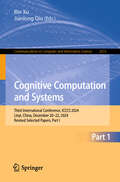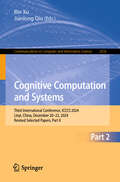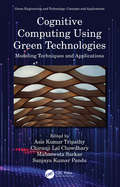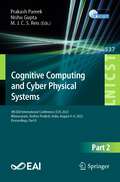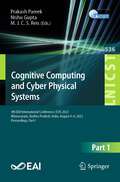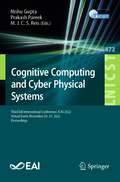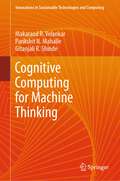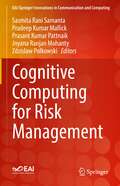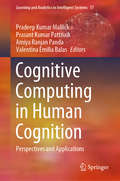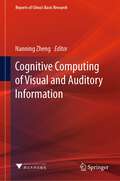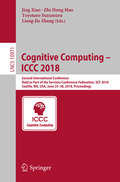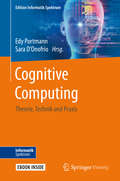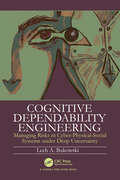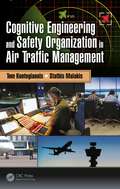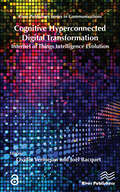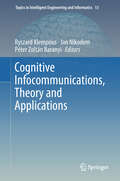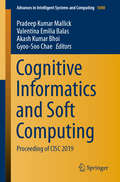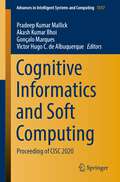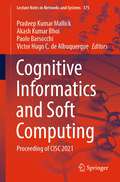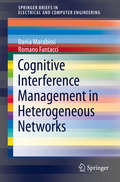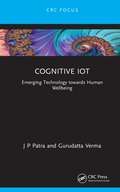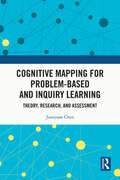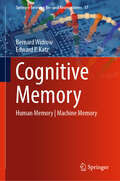- Table View
- List View
Cognitive Computation and Systems: Third International Conference, ICCCS 2024, Linyi, China, December 20–22, 2024, Revised Selected Papers, Part I (Communications in Computer and Information Science #2515)
by Bin Xu Jianlong QiuThis book constitutes the refereed proceedings of the Third International Conference on Cognitive Computation and Systems, ICCCS 2024, held in Linyi, China, December 20–22, 2024. The 54 revised full papers presented in these proceedings were carefully reviewed and selected from 155 submissions. The papers are organized in the following topical sections: Part I: Cognitive computing and information processing; Intelligent cooperative control; and Learning and systems. Part II: Cognitive computing and information processing; Intelligent cooperative control; and Learning and systems.
Cognitive Computation and Systems: Third International Conference, ICCCS 2024, Linyi, China, December 20–22, 2024, Revised Selected Papers, Part II (Communications in Computer and Information Science #2516)
by Bin Xu Jianlong QiuThis book constitutes the refereed proceedings of the Third International Conference on Cognitive Computation and Systems, ICCCS 2024, held in Linyi, China, December 20–22, 2024. The 54 revised full papers presented in these proceedings were carefully reviewed and selected from 155 submissions. The papers are organized in the following topical sections: Part I: Cognitive computing and information processing; Intelligent cooperative control; and Learning and systems. Part II: Cognitive computing and information processing; Intelligent cooperative control; and Learning and systems.
Cognitive Computing Using Green Technologies: Modeling Techniques and Applications (Green Engineering and Technology)
by Asis Kumar TripathyCognitive Computing is a new topic which aims to simulate human thought processes using computers that self-learn through data mining, pattern recognition, and natural language processing. This book focuses on the applications of Cognitive Computing in areas like Robotics, Blockchain, Deep Learning, and Wireless Technologies. This book covers the basics of Green Computing, discusses Cognitive Science methodologies in Robotics, Computer Science, Wireless Networks, and Deep Learning. It goes on to present empirical data and research techniques, modelling techniques and offers a data-driven approach to decision making and problem solving. This book is written for researchers, academicians, undergraduate and graduate students, and industry persons who are working on current applications of Cognitive Computing.
Cognitive Computing and Cyber Physical Systems: 4th EAI International Conference, IC4S 2023, Bhimavaram, Andhra Pradesh, India, August 4-6, 2023, Proceedings, Part II (Lecture Notes of the Institute for Computer Sciences, Social Informatics and Telecommunications Engineering #537)
by Nishu Gupta Prakash Pareek M. J. C. S. ReisThis 2-volume set constitutes the post-conference proceedings of the 4th International Conference on Cognitive Computing and Cyber Physical Systems, IC4S 2023, held in Bhimavaram, Andhra Pradesh, India, during August 4-6, 2023. The theme of IC4S 2023 was: cognitive approaches with machine learning and advanced communications. The 70 full papers were carefully reviewed and selected from 165 submissions. The papers are clustered in thematical issues as follows: machine learning and its applications; cyber security and signal processing; image processing; smart power systems; smart city eco-system and communications.
Cognitive Computing and Cyber Physical Systems: 4th EAI International Conference, IC4S 2023, Bhimavaram, Andhra Pradesh, India, August 4-6, 2023, Proceedings, Part I (Lecture Notes of the Institute for Computer Sciences, Social Informatics and Telecommunications Engineering #536)
by Nishu Gupta Prakash Pareek M. J. C. S. ReisThis 2-volume set constitutes the post-conference proceedings of the 4th EAI International Conference on Cognitive Computing and Cyber Physical Systems, IC4S 2023, Bhimavaram, Andhra Pradesh, India, during August 4-6, 2023. The theme of IC4S 2023 was: cognitive approaches with machine learning and advanced communications. The 70 full papers were carefully reviewed and selected from 165 submissions. The papers are clustered in thematical issues as follows: machine learning and its applications; cyber security and signal processing; image processing; smart power systems; smart city eco-system and communications.
Cognitive Computing and Cyber Physical Systems: Third EAI International Conference, IC4S 2022, Virtual Event, November 26-27, 2022, Proceedings (Lecture Notes of the Institute for Computer Sciences, Social Informatics and Telecommunications Engineering #472)
by Nishu Gupta Prakash Pareek M. J. C. S. ReisThis proceedings constitutes the post-conference proceedings of the 3rd EAI International Conference on Cognitive Computing and Cyber Physical Systems, IC4S 2022, held at Vishnu Institute of Technology, Bhimavaram in Andhra Pradesh, India, in November 26-27, 2022. The theme of IC4S 2022 was: cognitive computing approaches with data mining and machine learning techniques. The 22 full papers were carefully reviewed and selected from 88 submissions. The papers are clustered in thematical issues as follows: machine learning and its applications; cyber security and networking; image processing; IoT applications; smart city eco-system and communications.
Cognitive Computing for Machine Thinking (Innovations in Sustainable Technologies and Computing)
by Parikshit N. Mahalle Gitanjali R. Shinde Makarand R. VelankarThis book presents cognitive modeling along with the new paradigm machine thinking to enhance existing AI power and address its current limitations. This book provides overview of natural and artificial intelligence along with the computing models used currently. The need of advancing the current models is presented with suitable examples. The business case studies presented in different domains provide possible use of augmented intelligence with the proposed machine thinking paradigm. This book is targeted at academicians, researchers, students, professionals who belong to disciplines which involves intelligent computing and modelling human thinking. It provides possible multidisciplinary research directions including social psychology, artificial intelligence, HCI, cognition for applications in various domains.
Cognitive Computing for Risk Management (EAI/Springer Innovations in Communication and Computing)
by Prasant Kumar Pattnaik Pradeep Kumar Mallick Zdzislaw Polkowski Sasmita Rani Samanta Jnyana Ranjan MohantyThis book presents applications of cognitive management and cognitive computing in the fields of risk management, cognitive fraud detection, and in business decision making. The book provides insights on how cognitive management and cognitive computing enable businesses to quickly augment human intelligence and help humans perform tasks better. For example, the authors describe how by analyzing patterns in big data, small data, and "dark data," cognitive technologies can detect human behavior and suggest options for personalizing of products and services. The book studies companies in industries such as automotive, airline, health care, retail, wealth management, and litigation who have adopted these approaches.Presents applications of cognitive computing and cognitive management used in augmenting and empowering business decisions;Shows how to employ the Internet of Things in businesses using a cognitive management framework;Discusses technical aspects and alternatives to traditional tools, algorithms, and methodologies in cognitive computing.
Cognitive Computing in Human Cognition: Perspectives and Applications (Learning and Analytics in Intelligent Systems #17)
by Valentina Emilia Balas Prasant Kumar Pattnaik Pradeep Kumar Mallick Amiya Ranjan PandaThis edited book designs the Cognitive Computing in Human Cognition to analyze to improve the efficiency of decision making by cognitive intelligence. The book is also intended to attract the audience who work in brain computing, deep learning, transportation, and solar cell energy. Due to this in the recent era, smart methods with human touch called as human cognition is adopted by many researchers in the field of information technology with the Cognitive Computing.
Cognitive Computing of Visual and Auditory Information (Reports of China’s Basic Research)
by Nanning ZhengThis book discusses fruitful achievements in basic cognitive theories, processing technologies of visual and auditory information and research platforms. This book also can provide strong support for the research and development of artificial intelligence of major national projects, playing important roles in national application systems such as unmanned systems and smart cities. In addition, it has laid a solid foundation for the development of artificial intelligence in China. Intended for researchers who have been following the evolution of and trends in the artificial intelligence, the book is also a valuable reference resource for practitioners and scholars at various levels and in various fields.
Cognitive Computing – ICCC 2018: Second International Conference, Held as Part of the Services Conference Federation, SCF 2018, Seattle, WA, USA, June 25-30, 2018, Proceedings (Lecture Notes in Computer Science #10971)
by Jing Xiao Liang-Jie Zhang Zhi-Hong Mao Toyotaro SuzumuraThis book constitutes the proceedings of the International Conference on Cognitive Computing, ICCC 2018, held as part of SCF 2018, in Seattle, WA, USA, in June 2018. The 15 papers presented in this volume were carefully reviewed and selected from numerous submissions. The papers cover all aspects of Sensing Intelligence (SI) as a Service (SIaaS). Cognitive Computing is a sensing-driven computing (SDC) schema that explores and integrates intelligence from all types of senses in various scenarios and solution contexts.
Cognitive Computing: Theorie, Technik und Praxis (Edition Informatik Spektrum #63)
by Edy Portmann Sara D'OnofrioMit diesem Buch führen die Herausgeber den Begriff „Cognitive Computing“ ein. Unter Cognitive Computing werden verschiedene Technologieansätze wie künstliche neuronale Netze, Fuzzy-Systeme und evolutionäres Rechnen zusammengefasst mit dem Ziel, die kognitiven Fähigkeiten eines Menschen (Denken, Lernen, Schlussfolgern etc.) mithilfe von Computermodellen zu simulieren. Nebst den theoretischen Grundlagen widmet sich das Herausgeberwerk der Vielfalt verschiedener Anwendungsmöglichkeiten und zeigt erste Erfahrungen aus Pionierprojekten. Das Buch richtet sich gleichermaßen an Studierende, Fachleute aller Fachrichtungen sowie den interessierten Anwender. Es hilft dem Leser, die Bedeutungsvielfalt des Begriffs Cognitive Computing zu verstehen und verschiedene Einsatzmöglichkeiten im eigenen Umfeld zu erkennen und zu bewerten.
Cognitive Dependability Engineering: Managing Risks in Cyber-Physical-Social Systems under Deep Uncertainty
by Lech BukowskiThe work is a context-oriented analysis and synthesis of complex engineered systems to ensure continuous and safe operations under conditions of uncertainty. The book is divided in four parts, the first one comprises an overview of the development of systems engineering: starting with basics of Systems Science and Single Systems Engineering, through System of Systems Engineering to Cognitive Systems Engineering. The Cognitive Systems Engineering model was based on the concept of imperfect knowledge acquisition and management. The second part shows the evolutionary character of the dependability concept over the last fifty years. Beginning from simple models based on the classical probability theory, through the concepts of tolerating faults, as well as resilience engineering, we come to the assumptions of Cognitive Dependability Engineering (CDE), based on the concept of continuous smart operation, both under normal and abnormal conditions. The subject of the next part is analysis and synthesis of Cyber-Physical-Social (CPS) Systems. The methodology consists of the following steps: modeling CPS systems' structure, simulating their behavior in changing conditions and in situations of disruptions, and finally assessing the dependability of the entire system based on CDE. The last part of the work answers the question of how to deal with risks in CPS systems in situations of high level of uncertainty. The concept of a Cognitive Digital Twin was introduced to support the process of solving complex problems by experts, and on this basis a framework for cognitive dependability based problemsolving in CPS Systems operating under deep uncertainty was developed. The possibilities and purposefulness of using this framework have been demonstrated with three practical examples of disasters that have happened in the past and have been thoroughly analyzed.
Cognitive Engineering and Safety Organization in Air Traffic Management
by Tom Kontogiannis Stathis MalakisThis book covers the Air Traffic Management (ATM) environment and the controller-crew interactions. The International Civil Aviation Organization (ICAO) regulations and organizational procedures are also presented in a succinct manner so that novel and experienced aviation practitioners appreciate how safety organization affects their cognitive performance. The book distills theoretical knowledge about human cognition and presents real examples and case studies to help readers understand how air traffic controllers make sense of difficult situations, make decisions under time pressure, detect and correct their errors, and adapt their performance to complex situations.
Cognitive Hyperconnected Digital Transformation: Internet of Things Intelligence Evolution
by Ovidiu Vermesan Joël BacquetCognitive Hyperconnected Digital Transformation provides an overview of the current Internet of Things (IoT) landscape, ranging from research, innovation and development priorities to enabling technologies in a global context. It is intended as a standalone book in a series that covers the Internet of Things activities of the IERC-Internet of Things European Research Cluster, including both research and technological innovation, validation and deployment. The book builds on the ideas put forward by the European Research Cluster, the IoT European Platform Initiative (IoT-EPI) and the IoT European Large-Scale Pilots Programme, presenting global views and state-of-the-art results regarding the challenges facing IoT research, innovation, development and deployment in the next years. Hyperconnected environments integrating industrial/business/consumer IoT technologies and applications require new IoT open systems architectures integrated with network architecture (a knowledge-centric network for IoT), IoT system design and open, horizontal and interoperable platforms managing things that are digital, automated and connected and that function in real-time with remote access and control based on Internet-enabled tools. The IoT is bridging the physical world with the virtual world by combining augmented reality (AR), virtual reality (VR), machine learning and artificial intelligence (AI) to support the physical-digital integrations in the Internet of mobile things based on sensors/actuators, communication, analytics technologies, cyber-physical systems, software, cognitive systems and IoT platforms with multiple functionalities. These IoT systems have the potential to understand, learn, predict, adapt and operate autonomously. They can change future behaviour, while the combination of extensive parallel processing power, advanced algorithms and data sets feed the cognitive algorithms that allow the IoT systems to develop new services and propose new solutions. IoT technologies are moving into the industrial space and enhancing traditional industrial platforms with solutions that break free of device-, operating system- and protocol-dependency. Secure edge computing solutions replace local networks, web services replace software, and devices with networked programmable logic controllers (NPLCs) based on Internet protocols replace devices that use proprietary protocols. Information captured by edge devices on the factory floor is secure and accessible from any location in real time, opening the communication gateway both vertically (connecting machines across the factory and enabling the instant availability of data to stakeholders within operational silos) and horizontally (with one framework for the entire supply chain, across departments, business units, global factory locations and other markets). End-to-end security and privacy solutions in IoT space require agile, context-aware and scalable components with mechanisms that are both fluid and adaptive. The convergence of IT (information technology) and OT (operational technology) makes security and privacy by default a new important element where security is addressed at the architecture level, across applications and domains, using multi-layered distributed security measures. Blockchain is transforming industry operating models by adding trust to untrusted environments, providing distributed security mechanisms and transparent access to the information in the chain. Digital technology platforms are evolving, with IoT platforms integrating complex information systems, customer experience, analytics and intelligence to enable new capabilities and business models for digital business.
Cognitive Infocommunications, Theory and Applications (Topics in Intelligent Engineering and Informatics #13)
by Ryszard Klempous Jan Nikodem Péter Zoltán BaranyiThe book gathers the chapters of Cognitive InfoCommunication research relevant to a variety of application areas, including data visualization, emotion expression, brain-computer interfaces or speech technologies. It provides an overview of the kind of cognitive capabilities that are being analyzed and developed. Based on this common ground, it may become possible to see new opportunities for synergy among disciplines that were heretofore viewed as being separate.Cognitive InfoCommunication begins by modeling human cognitive states and aptitudes in order to better understand what the user of a system is capable of comprehending and doing. The patterns of exploration and the specific tools that are described can certainly be of interest and of great relevance for all researchers who focus on modeling human states and aptitudes.This innovative research area provides answers to the latest challenges in influence of cognitive states and aptitudes in order to facilitate learning or generally improve performance in certain cognitive tasks such as decision making. Some capabilities are purely human, while others are purely artificial, but in general this distinction is rarely clear-cut. Therefore, when discussing new human cognitive capabilities, the technological background which makes them possible cannot be neglected, and indeed often plays a central role.This book highlights the synergy between various fields that are perfectly fit under the umbrella of CogInfoCom and contribute to understanding and developing new, human-artificial intelligence hybrid capabilities. These, merged capabilities are currently appearing, and the importance of the role they play in everyday life are unique to the cognitive entity generation that is currently growing up.
Cognitive Informatics and Soft Computing: Proceeding of CISC 2019 (Advances in Intelligent Systems and Computing #1040)
by Valentina Emilia Balas Akash Kumar Bhoi Pradeep Kumar Mallick Gyoo-Soo ChaeThe book presents new approaches and methods for solving real-world problems. It highlights, in particular, innovative research in the fields of Cognitive Informatics, Cognitive Computing, Computational Intelligence, Advanced Computing, and Hybrid Intelligent Models and Applications. New algorithms and methods in a variety of fields are presented, together with solution-based approaches. The topics addressed include various theoretical aspects and applications of Computer Science, Artificial Intelligence, Cybernetics, Automation Control Theory, and Software Engineering.
Cognitive Informatics and Soft Computing: Proceeding of CISC 2020 (Advances in Intelligent Systems and Computing #1317)
by Akash Kumar Bhoi Pradeep Kumar Mallick Victor Hugo C. de Albuquerque Gonçalo MarquesThis book presents best selected research papers presented at the 3rd International Conference on Cognitive Informatics and Soft Computing (CISC 2020), held at Balasore College of Engineering & Technology, Balasore, Odisha, India, from 12 to 13 December 2020. It highlights, in particular, innovative research in the fields of cognitive informatics, cognitive computing, computational intelligence, advanced computing, and hybrid intelligent models and applications. New algorithms and methods in a variety of fields are presented, together with solution-based approaches. The topics addressed include various theoretical aspects and applications of computer science, artificial intelligence, cybernetics, automation control theory, and software engineering.
Cognitive Informatics and Soft Computing: Proceeding of CISC 2021 (Lecture Notes in Networks and Systems #375)
by Akash Kumar Bhoi Pradeep Kumar Mallick Victor Hugo C. de Albuquerque Paolo BarsocchiThis book presents best selected research papers presented at the 4th International Conference on Cognitive Informatics and Soft Computing (CISC 2021), held at Balasore College of Engineering & Technology, Balasore, Odisha, India, from 21–22 August 2021. It highlights, in particular, innovative research in the fields of cognitive informatics, cognitive computing, computational intelligence, advanced computing, and hybrid intelligent models and applications. New algorithms and methods in a variety of fields are presented, together with solution-based approaches. The topics addressed include various theoretical aspects and applications of computer science, artificial intelligence, cybernetics, automation control theory, and software engineering.
Cognitive Interference Management in Heterogeneous Networks (SpringerBriefs in Electrical and Computer Engineering)
by Dania Marabissi Romano FantacciThis brief investigates the role of interference management in Heterogeneous Networks (Het Nets), focusing on cognitive approaches and the use of beamforming. Key concepts of Het Nets are introduced and different deployment strategies are examined, such as sharing the same frequency band of the macro cells or using new high frequency bands. Particular attention is devoted to co-channel deployment and to the problem of interference management, addressing various strategies that can be adopted to handle the interference between the cells. In addition, the brief explores cognitive small cells which are able to avoid or limit interference by using suitable beamforming and resource allocation schemes. The suggested solutions are supported by numerical results in terms of performance evaluations and comparisons.
Cognitive Internet of Medical Things for Smart Healthcare: Services and Applications (Studies in Systems, Decision and Control #311)
by Aboul Ella Hassanien Deepak Gupta K. Shankar Adam Slowik Aditya KhampariaThis book aims to provide a detailed understanding of IoMT-supported applications while engaging premium smart computing methods and improved algorithms in the field of computer science. It contains thirteen chapters discussing various applications under the umbrella of the Internet of Medical Things. These applications geared towards IoMT cloud analysis, machine learning, computer vision and deep learning have enabled the evaluation of the proposed solutions.
Cognitive IoT: Emerging Technology towards Human Wellbeing (Intelligent Signal Processing and Data Analysis)
by J P Patra Gurudatta VermaThis book deals with a different research area of cognitive IoT and explains how machine learning algorithms can be applied for cognitive IoT. It deals with applications of cognitive IoT in this pandemic (COVID-19), applications for student performance evaluation, applications for human healthcare for chronic disease prediction, use of wearable sensors and review regarding their energy optimization and how cognitive IoT helps in farming through rainfall prediction and prediction of lake levels. Features: Describes how cognitive IoT is helpful for chronic disease prediction and processing of data gathered from healthcare devices. Explains different sensors available for health monitoring. Explores application of cognitive IoT in COVID-19 analysis. Discusses pertinent and efficient farming applications for sustaining agricultural growth. Reviews smart educational aspects such as student response, performance, and behavior and instructor response, performance, and behavior. This book aims at researchers, professionals and graduate students in Computer Science and Engineering, Computer Applications and Electronics Engineering, and Wireless Communications and Networking.
Cognitive Machine Intelligence: Applications, Challenges, and Related Technologies (Intelligent Data-Driven Systems and Artificial Intelligence)
by Mariya Ouaissa Inam Ullah Khan Salma El Hajjami Tarandeep Kaur Bhatia Salwa BelaqzizCognitive Machine Intelligence: Applications, Challenges, and Related Technologies offers a compelling exploration of the transformative landscape shaped by the convergence of machine intelligence, artificial intelligence, and cognitive computing. In this book, the authors navigate through the intricate realms of technology, unveiling the profound impact of cognitive machine intelligence on diverse fields such as communication, healthcare, cybersecurity, and smart city development. The chapters present study on robots and drones to the integration of machine learning with wireless communication networks, IoT, quantum computing, and beyond. The book explores the essential role of machine learning in healthcare, security, and manufacturing. With a keen focus on privacy, trust, and the improvement of human lifestyles, this book stands as a comprehensive guide to the novel techniques and applications driving the evolution of cognitive machine intelligence. The vision presented here extends to smart cities, where AI-enabled techniques contribute to optimal decision-making, and future computing systems address end-to-end delay issues with a central focus on Quality-of-Service metrics. Cognitive Machine Intelligence is an indispensable resource for researchers, practitioners, and enthusiasts seeking a deep understanding of the dynamic landscape at the intersection of artificial intelligence and cognitive computing.This book: Covers a comprehensive exploration of cognitive machine intelligence and its intersection with emerging technologies such as federated learning, blockchain, and 6G and beyond. Discusses the integration of machine learning with various technologies such as wireless communication networks, ad-hoc networks, software-defined networks, quantum computing, and big data. Examines the impact of machine learning on various fields such as healthcare, unmanned aerial vehicles, cybersecurity, and neural networks. Provides a detailed discussion on the challenges and solutions to future computer networks like end-to-end delay issues, Quality of Service (QoS) metrics, and security. Emphasizes the need to ensure privacy and trust while implementing the novel techniques of machine intelligence. It is primarily written for senior undergraduate and graduate students, and academic researchers in the fields of electrical engineering, electronics and communication engineering, and computer engineering.
Cognitive Mapping for Problem-based and Inquiry Learning: Theory, Research, and Assessment
by Juanjuan ChenThis book studies how to improve problem-based and inquiry-based learning by incorporating cognitive maps. Problem-based learning and cognitive mapping are reviewed from the perspective of both learning sciences and cognitive sciences, including the underpinning theories of experiential learning, situated learning, collaborative learning, meaningful learning, externalized representations and visual representations. The result is a comprehensive review and analysis of cognitive mapping-supported problem-based learning, with the topic discussed from cognitive, meta-cognitive, social, and motivational and emotional perspectives. Furthermore, the author presents a theory-driven design, implementation, and analysis of design-based research to improve problem-based learning using cognitive mapping. The book will provide implications for researchers and practitioners of learning sciences, psychology, instructional systems, and cognitive tools.
Cognitive Memory: Human Memory | Machine Memory (Springer Series on Bio- and Neurosystems #17)
by Bernard Widrow Edward P. KatzHow does human memory work? How does human pattern recognition work? The book’s motivation is twofold, to add to knowledge in the field of neuroscience, and to design a highly simplified cognitive memory constructed using software and existing electronic components. Readers are taken on an inspiring journey through the fundamentals of human memory, how it is constructed, and how it works in everyday life. The book goes more in-depth into the human side of cognitive memory — how seeing, hearing, walking and speaking works. Impairments in cognitive memory are also discussed. Lastly, the book sheds light on how meaning is extracted from sensory inputs and from stored data. This book is not without controversy. Neuroscientists accept the engrams (or memory traces) model that long-term memory is stored in the brain’s neural networks. The authors believe that long-term human memory is stored digitally, in the DNA of brain cells, and not in analog neural networks. Further, the authors believe that innate knowledge of humans and animals is inherited, transmitted from parents to offspring at the moment of conception. The single cell contains the innate knowledge in the DNA of its nucleus. Memory is stored in DNA. The brain’s neural networks are for access and retrieval of memory and not for actual storage. This book offers a unique, inspiring reading to researchers and other readers interested in the science of memory.
